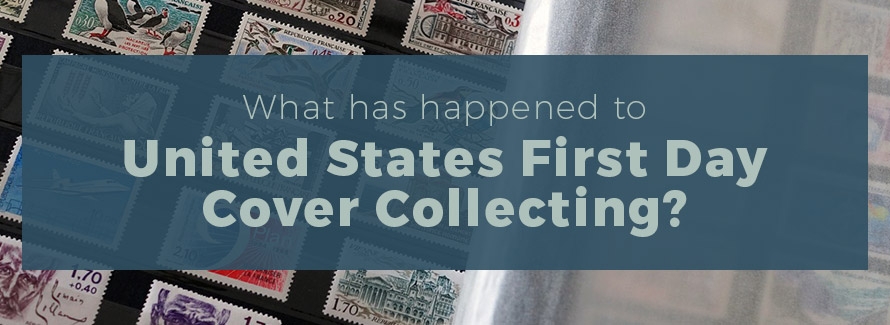
Stamp collectors in the early 1900’s had a very different set of concerns than do collectors today. A hundred years ago, new stamp issues were few and far between. Post Offices hadn’t yet learned that they could subsidize postal operations by issuing stamps that collectors would buy and put in their collections. Every stamp that a collector buys and never uses is a donation to the Post Office and helps underwrite the cost of postal service (last year hundreds of millions of dollars of new issue postage stamps were bought by collectors worldwide to put away in their collections). A hundred or more years ago, postage rates were so low (and collectors so few) that postal agencies never thought to issue stamps to attract collectors.
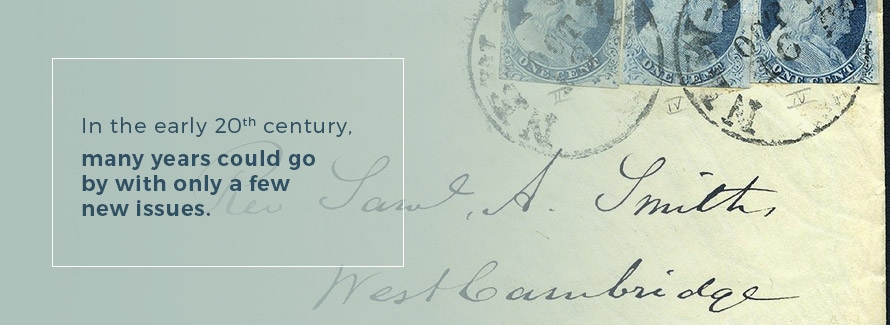
Stamp collectors who lived a century ago were constrained in the enjoyment of their hobby by the lack of new postal issues. In 1911, for instance, there were no new United States stamp issues (in 2011, a hundred years later, there were over sixty different stamp issues with a postage value of over $57.) Many years could go by with only a few new issues. Collectors, who were just as avid and driven then as collectors are today, were always searching for new items to add to their collection. They discovered plate blocks, which began in the 1890’s when the US Bureau of Engraving and Printing began printing US stamps and put plate numbers in the margins of sheets to help them evaluate plate wear and quality. Collectors began to look for shades and cancels as well-all ways to expand the collecting experience in a time of few postal issues. And collectors began to desire stamps that indicated that they were used on the first day that they were available for postage.
The Early Years of First Day Cover Collecting
The origins of First Day Cover (FDC) collecting are obscure. Certainly, there are FDCs going back to the late nineteenth century. But these are accidentals- people who happened to buy a stamp on its day of issue and used it on mail. Gimbels, the famous Philadelphia department store, mailed all of their monthly statements on May 1, 1901 with the new 2c Pan American stamp (Scott #294). Almost no one collected FDCs in 1901 and many of the envelopes, after the bill was paid, were put aside in filing drawers. Today, when they are found, they are worth over $2000.
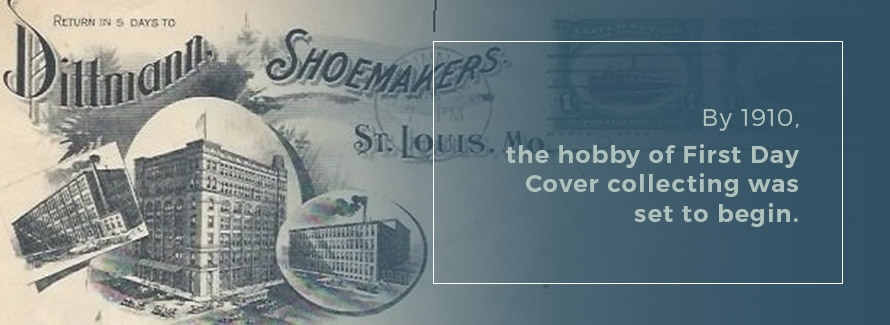
By 1910, the hobby of First Day Cover collecting was set to begin. Collectors began to find and esteem older envelopes that were cancelled on the first day that the stamp had been issued. Articles appeared in the contemporary press alerting collectors to finds of older FDCs and soon collectors were hunting for discoveries of their own. And the US Post Office, in a decision that great advanced FDC collecting, began to announce, often months in advance, new issues that were going to come out. This gave budding First Day Cover collectors time to prepare to buy the new stamps and have them used on the first day of issue.
One of the forefathers of First Day Cover collecting was the great Philadelphia philatelist Phillip Ward. Ward began making his first FDCs when still a school boy in 1912. His first effort was for the 2c Lincoln issues of 1912 (Scott #367). By 1920, led by collectors like Edward Worden, First Day Cover collecting had a devoted following. But FDCs could still only be told by the date of the cancellation on the envelope. It wasn’t until 1923 that the first envelope cachet, indicating that the cover is a FDC, and what the purpose of the stamp was, that FDC collecting entered its modern phase. This first cachet was on the 1923 Harding memorial issue that was released for the recently deceased President Warren Harding. The famous Harding cachet was designed and issued by George Linn, who was the publisher of the famous Linn’s stamp magazine, which is still the mainstay philatelic publication today.
Throughout the 1920’s and for most of the rest of the last century, First Day Cover collecting continued to gain in popularity and the older FDCs shot up in price. The emphasis in FDC collecting was increasingly on the cachets-the printed portion of the envelope design that complimented the philatelic issue that was commemorating some aspect of American history. By 1940, most US collectors collected First Day Covers as part of their US collection.
First Day Cover Collecting After WW II
Beginning in the 1950’s and 1960’s First Day Cover collecting became more cachet collecting than anything else. Many collectors went back and tried to obtain the “classic cachets” of the 1920s and 1930s and by 1970, there were scores of cachet makers who created envelopes for every new stamp that came out. Because no cachet had official US Post Office authorization, collectors were often puzzled as to which cachet to collect. But certainly, by 1980, a collector would have needed fifty or more of most US new issue FDCs to claim a complete collection according to cachet maker.
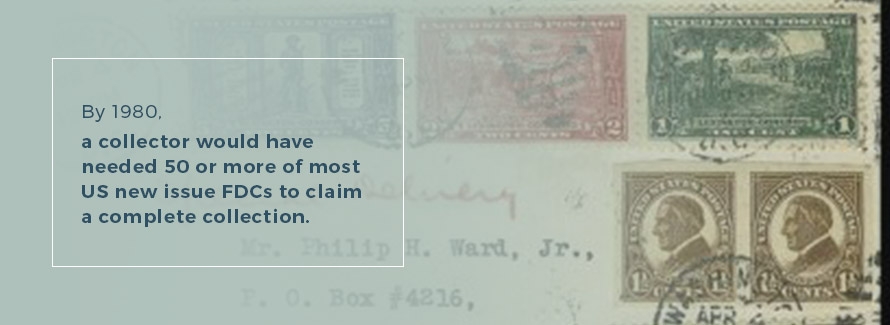
The slow end of US First Day Cover collecting began about 1975 with the entry of both the Franklin Mint and Reader’s Digest into the monthly FDC market. Both companies operated a monthly service that sent numerous FDCs to subscribers. The prices were high-usually close to $10 each for a cover that had a 13c or 15c stamp (the postage rate in the 1970s) and a 5c envelope. Millions of dollars of these postal products were sold into the philatelic marketplace, often to casual collectors who had no idea of their real value and that they were buying souvenirs, not collectibles.
By 2000, the philatelic FDC marketers were largely gone, having left millions of collectors with hundreds of millions of dollars cost in material that was very overpriced, undesirable, and not collected by modern philatelists. This occurred at the same time that the US Postal Service began to juice up their stamp production machinery, issuing up to one hundred or more stamps per year, at a postage cost of hundreds of dollars. The average US collector didn’t need FDC collecting anymore to keep busy with his hobby. He had plenty of stamps to collect. Add to that, First Day cover collecting takes up a lot of room. A very comprehensive US stamp collection can be housed in just a few albums. Not so for First Day Covers. There have been nearly 3000 US postal issues that have had cacheted FDCs issued for them. First Day Cover albums usually house a hundred covers making a comprehensive collection not only expensive in terms of albums but invasive (30-50 albums) in terms of space.
The First Day Cover Market Today
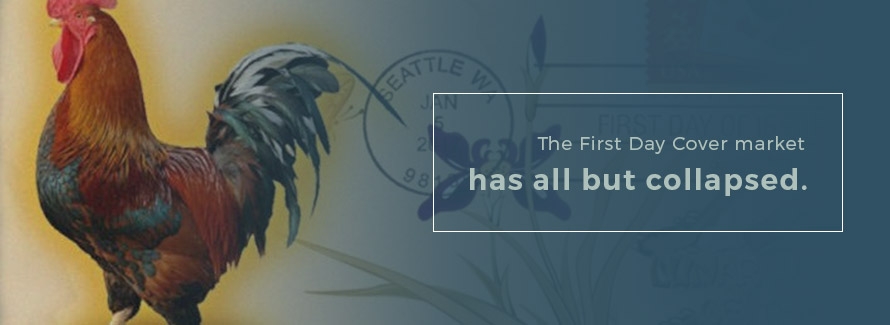
The First Day Cover market has all but collapsed. Some of the classic (pre 1930) FDC are still sought by serious collectors and a few hardy old timers still attempt to put together collections not by stamp but by cachet maker. But for the most part, few newer collectors entering the hobby have the time, money or inclination to assemble a First Day Cover collection. There are just too many stamps to collect and not enough time or money.
Certainly anyone finding or inheriting a collection of First Day Covers should seek a professional opinion (we offer ours for free - just contact us). But as a rule of thumb, dealers sell First Day Covers from 1950-2000, if cacheted and unaddressed, at 10c or less each. Collecting fashions change over the years and what was once popular often is not anymore. And while there is still an active market for US and Foreign stamps, the market for First Day Covers continues to fade away.
